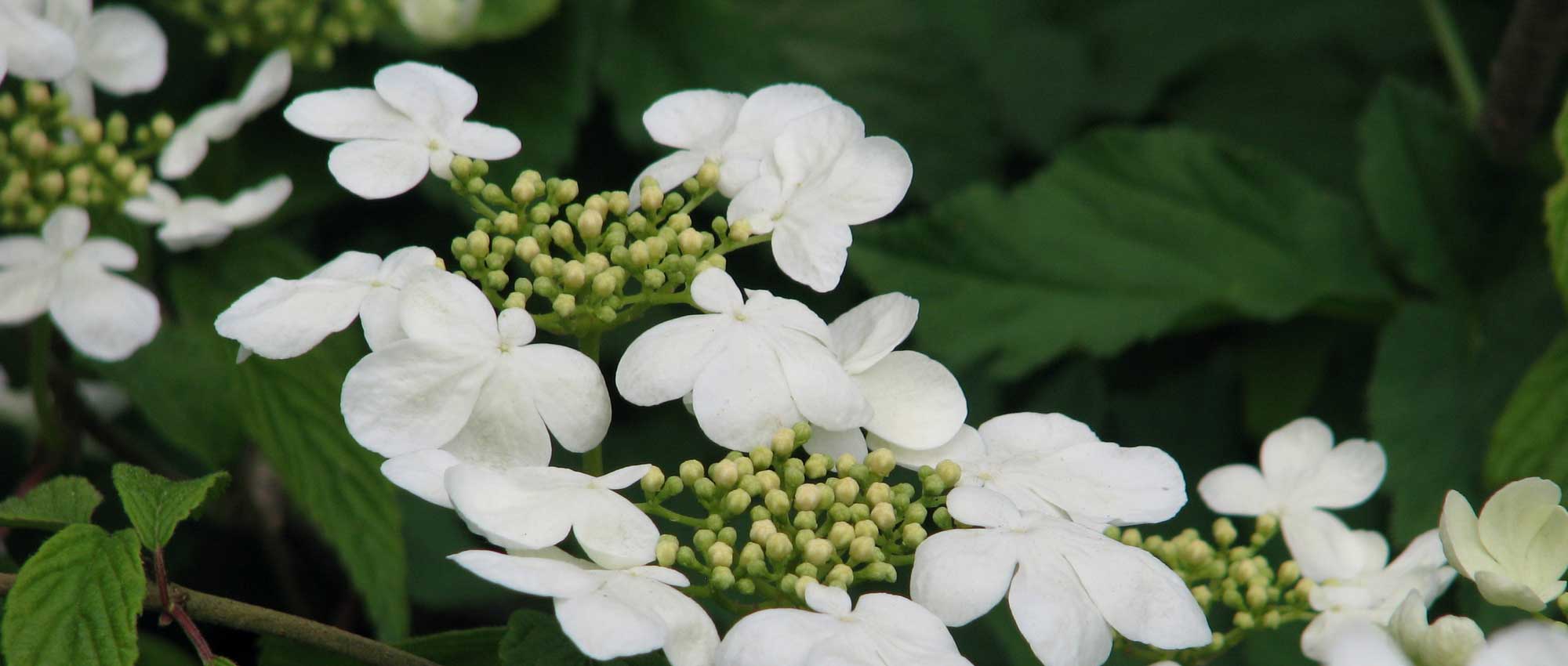
Viburnum: 8 successful pairing ideas
Discover our inspirations!
Contents
Viburnums are decorative in every season with their early flowering, berries, and foliage! In winter or spring, they offer an abundant display of white or pink flowers, grouped in dense and delicate inflorescences. These are followed by red, blue, or black berries, which can even be yellow! In autumn, the foliage of deciduous species takes on remarkable shades of orange-red! The foliage of evergreen viburnums creates a screen that will protect you from prying eyes even in the middle of winter. Viburnums can thus be included in the composition of a rustic hedge, in association with various shrubs that have a rather wild and natural style.
With their fairly neutral foliage and very light flowering, you can pair them with most other flowers and foliage! Numerous combinations are possible. With flowers in pale tones (white, pink, mauve…), they create a romantic effect. It is with these cool and soft colours that the most beautiful colour marriages are achieved to integrate viburnums. They lighten dark flower beds and bring brightness to shaded gardens. Discover how and with which plants to associate them in the garden!
In a hedge, for a natural and rustic effect!
Viburnums make a stunning impact in a living hedge, composed of a wide variety of species! Evergreen viburnums allow you to hide from prying eyes all year round: choose Viburnum rhytidophyllum or Viburnum tinus for their dense foliage. A free-form hedge offers a great diversity of colours and shapes, with varied flowering and foliage. It will require little maintenance and will be beneficial for biodiversity. It has a much more vibrant and natural appearance than monospecific hedges. The Viburnum opulus fits perfectly into the composition of these rustic hedges! Mix spring and winter flowering varieties to achieve a decorative hedge all year round. Plant viburnums alternately with Spiraeas (for example, Spiraea x vanhouttei), Cornels, or Mock Oranges. Enjoy decorative and evergreen shrubs, such as Photinia x fraseri ‘Red Robin’ with its red hues.

In a living hedge, you can combine, from left to right, Philadelphus coronarius (photo Malte), Viburnum opulus ‘Roseum’ (photo Maja Dumat), and Spiraea x vanhouttei
For a romantic atmosphere
The pale pink and highly fragrant flowers of viburnums create a soft and romantic effect. Choose Viburnum x bodnantense, with its pleasantly scented pale pink winter flowering! Plant the Viburnum lantana, which has a very delicate appearance, alongside Kolkwitzias or Weigelias, two bushes with impressive white or pink spring flowering. To accompany them, choose plants in soft colours, in shades of white, pink, mauve, or pale blue. You can plant some perennials or bulbs in front of them, such as Geranium macrorrhizum, Alliums, Camassias, or Lily of the Valley.
Get inspired by this atmosphere.

The soft hues of Viburnum lantana (photo Mickael Pierce), Weigela florida, and Kolkwitzia amabilis
Discover other Viburnum
View all →Available in 3 sizes
Available in 2 sizes
Available in 1 sizes
Available in 1 sizes
Available in 4 sizes
Available in 2 sizes
Available in 1 sizes
Available in 4 sizes
Available in 2 sizes
Available in 1 sizes
In the background of a flower bed
Viburnums add volume and create a valuable backdrop for hiding a wall and forming a beautiful green screen. For this purpose, choose evergreen varieties, such as Viburnum tinus ‘Eve Price’. In summer, with their fairly classic foliage, viburnums are neutral and will not overshadow the vibrant colours of the flowers you can plant at their feet. And, for spring, you can accompany their flowering with spring bulbs and perennials: Tulips, Lily of the Valley, Iberis, Brunnera macrophylla… Plant them in large numbers in front of the viburnums to create a true carpet of flowers at their feet.
To create a beautiful backdrop, combine deciduous Viburnums with some shrubs that have decorative foliage, which take on stunning colours in autumn. Cornus kousa ‘Samaritan’ is an excellent companion for Viburnum opulus or lantana. It flowers at the same time, has beautiful variegated foliage that will brighten the shaded areas of your garden, and takes on purplish hues in autumn. Just like Physocarpus, which flowers at the same time and offers superb foliage that is often golden yellow or purple, along with decorative fruits.
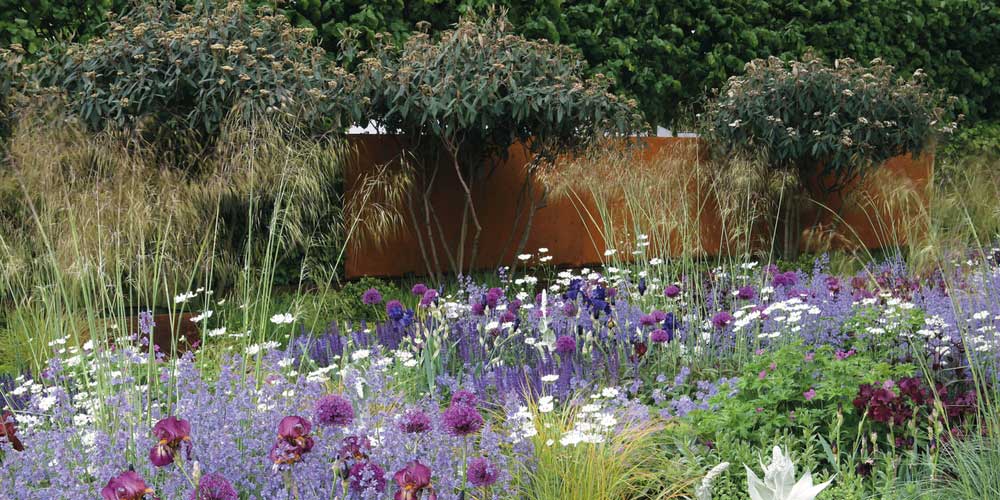
An alignment of Viburnum rhytidophyllum creates a lovely backdrop! Here, with Allium, Stipa gigantea, Nepeta, Stachys, Geranium, and Iris germanica (Photo: MAP / Nicole et Patrick Mioulane/ Landscape designer Tom Stuart Smith)
In a container, on a terrace, or in a small garden
If you have limited space, or simply wish to green up a terrace, choose the most compact and low-growing varieties, such as Viburnum davidii or Viburnum tinus. Plant them in large containers so they can develop well. They are quite undemanding and enjoy the sun. Bring some colour to the base of Viburnum tinus ‘Eve Price’ with a few flowers: Hyacinths, Primroses, Crocus tommasinianus or Muscari. You can also opt for small perennials or ornamental grasses, such as Ophiopogon planiscapus or Hakonechloa macra.
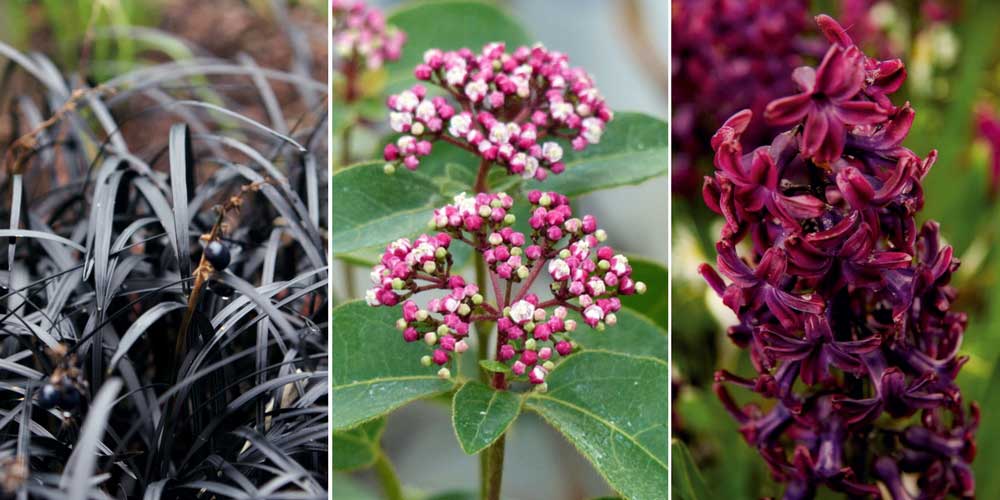
Ophiopogon planiscapus ‘Nigrescens’ (photo Brewbooks), Viburnum tinus ‘Lisarose’ and Hyacinth ‘Woodstock’
With ericaceous plants
Some species, such as Viburnum davidii, thrive in acidic soils: take advantage of this to create a heather soil bed! Choose a location in partial shade, with cool, acidic soil. You can compose the bed at the foot of a large tree. If you have a magnolia or a tall conifer, make the most of it; they will be perfect for protecting the bed from the sun! Pair your viburnums with rhododendrons or hydrangeas and plant some heathers at their feet. Also, discover the stunning evergreen foliage in red tones of Pieris japonica (Andromeda).

Rhododendron ‘Shiryou no Homara’, Viburnum davidii, and Pieris japonica ‘Little Heath’ (photo Megan Hansen)
To create a rockery
The Viburnum davidii is the most suitable species for creating a rockery! It has a compact and spreading habit, can be used as ground cover, is easy to grow, and enjoys full sun. Plant it at the back of the border accompanied by dwarf conifers, such as Thuya orientalis ‘Aurea Nana’ or Juniperus communis ‘Compressa’. Create flower carpets in front of them with Iberis sempervirens, Gentiana acaulis, Viola odorata, or Saxifrages, which you will plant in small groups. Scatter a few clumps of grasses in the border, or, if the location is shaded, some ferns like the Hart’s tongue fern (Asplenium scolopendrium).
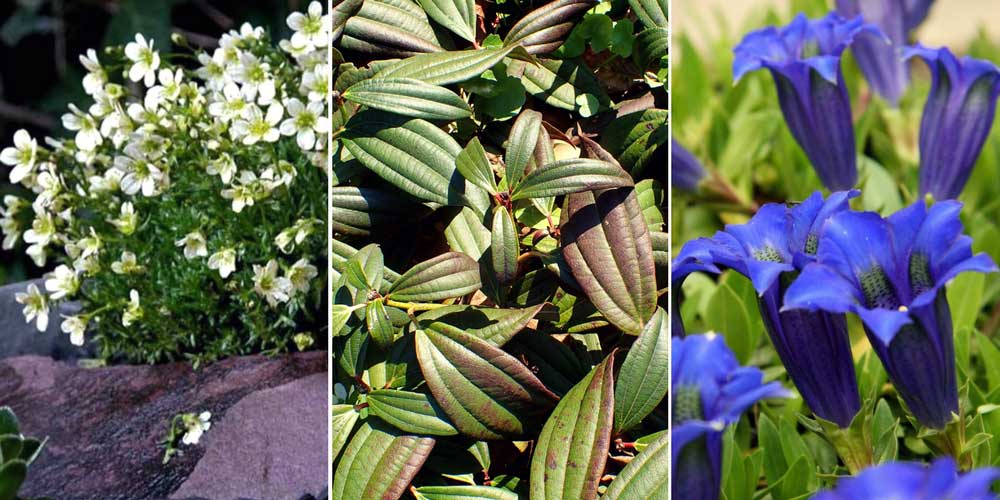
Saxifraga ‘Pixie White’, Viburnum davidii (photo Krzysztof Ziarnek, Kenraiz) and Gentiana acaulis (photo Maja Dumat)
With spring or winter flowering bushes
Pair spring-flowering varieties, such as Viburnum lantana or plicatum, with the abundant pink flowering of Japanese Cherry Trees (Prunus serrulata), or the white flowering of Deutzias. You can place Hydrangea petiolaris alongside and let it climb against the wall of your house. To create a highly fragrant spring border, opt for Mock Oranges or Lilacs! As for Kalmia latifolia, it will provide you with pale pink or white spring flowers. To accompany winter-flowering Viburnums, such as Viburnum x bodnantense, choose Camellia sasanqua or Sarcococca, two bushes that offer fragrant blooms during winter!
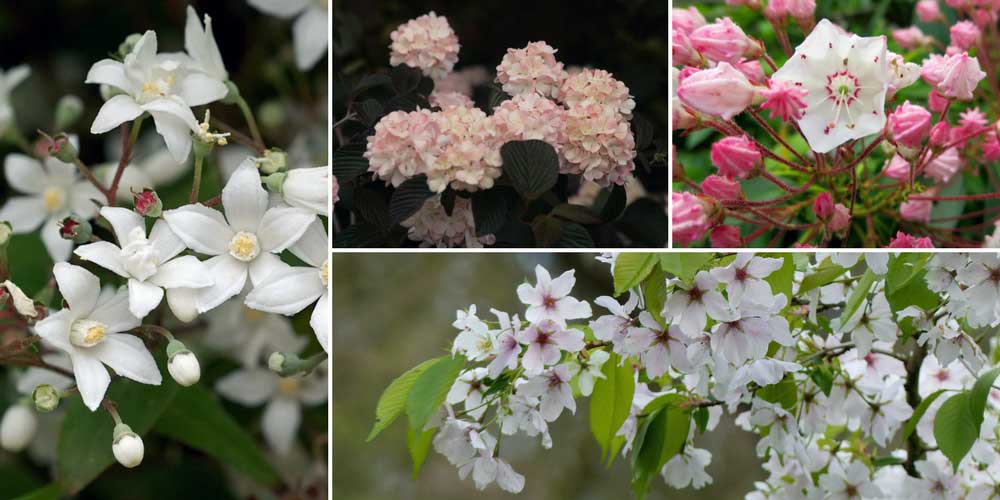
Deutzia setchuenensis var. corymbiflora, Viburnum plicatum ‘Mary Milton’, Kalmia latifolia and Prunus serrulata ‘Amagi Yoshino’
… And in isolation!
Although viburnums pair very well with a large number of bushes and flowers, feel free to plant certain varieties in isolation, for example in the middle of a short grass meadow. This is what we recommend for Viburnum plicatum or Viburnum opulus ‘Roseum’. Their flowering is so spectacular that they deserve to be planted in isolation! The architectural habit of Viburnum plicatum will stand out much better this way! You can also enhance them by placing just a few ground cover plants at their base, such as a tapetum of periwinkles, or bulbs.
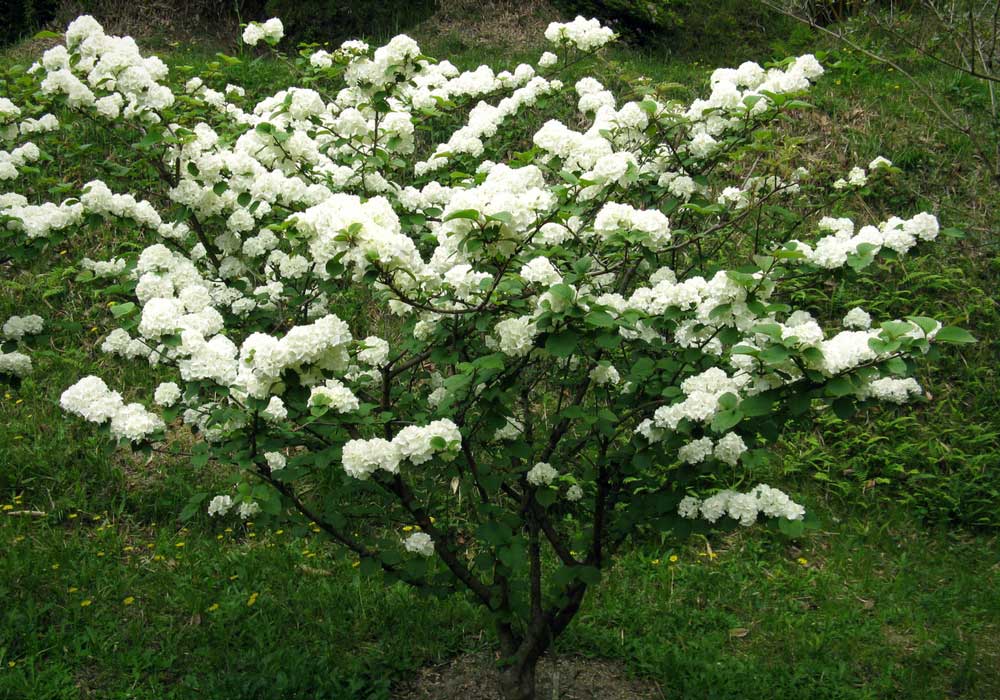
Viburnum plicatum var. plicatum (photo KENPEI)
- Subscribe!
- Contents































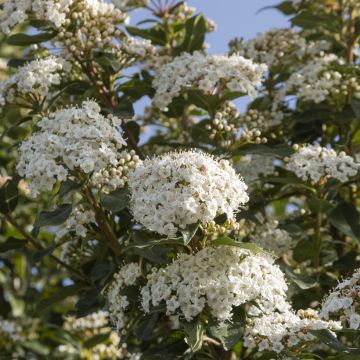
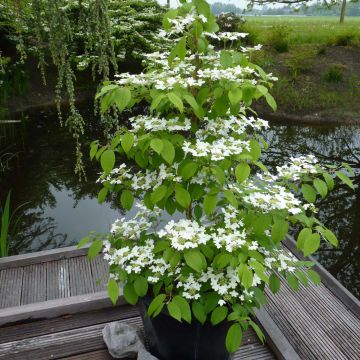
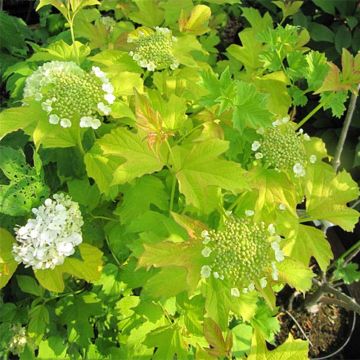
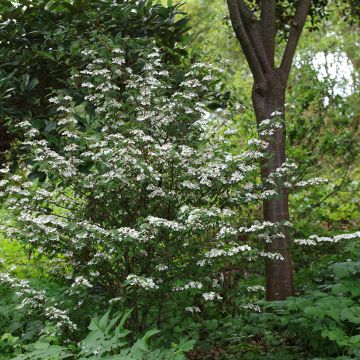
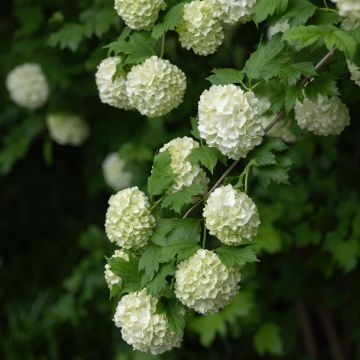

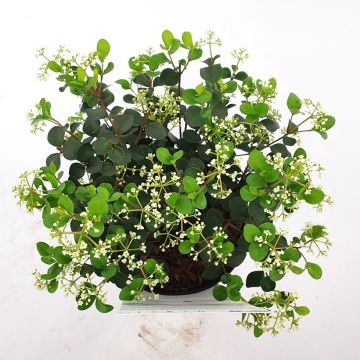

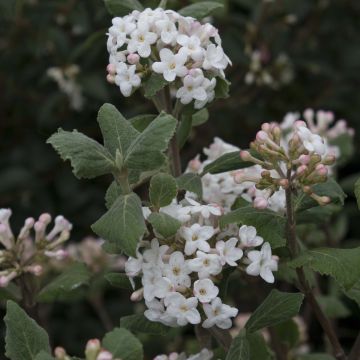
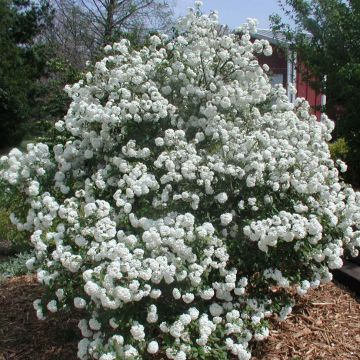
Comments